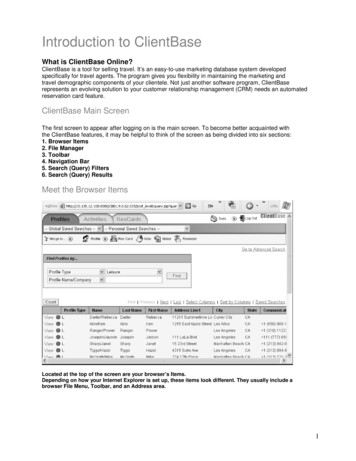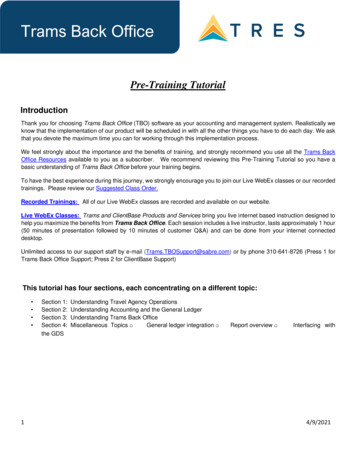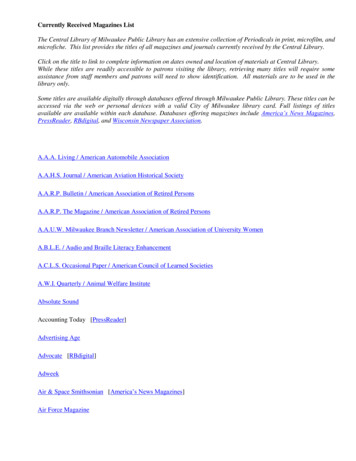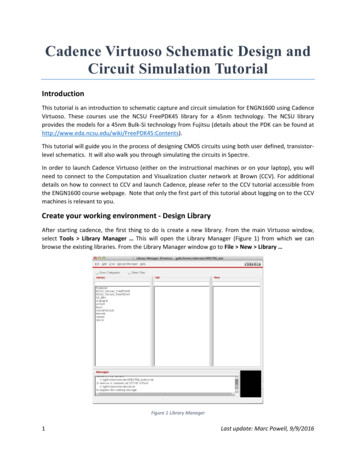
Transcription
Introduction to ClientBaseWhat is ClientBase Online?ClientBase is a tool for selling travel. It’s an easy-to-use marketing database system developedspecifically for travel agents. The program gives you flexibility in maintaining the marketing andtravel demographic components of your clientele. Not just another software program, ClientBaserepresents an evolving solution to your customer relationship management (CRM) needs an automatedreservation card feature.ClientBase Main ScreenThe first screen to appear after logging on is the main screen. To become better acquainted withthe ClientBase features, it may be helpful to think of the screen as being divided into six sections:1. Browser Items2. File Manager3. Toolbar4. Navigation Bar5. Search (Query) Filters6. Search (Query) ResultsMeet the Browser ItemsLocated at the top of the screen are your browser’s Items.Depending on how your Internet Explorer is set up, these items look different. They usually include abrowser File Menu, Toolbar, and an Address area.1
Meet the File Managers (Profiles & Activities)The File Managers consists of Profiles and Activities.Profiles provide quick access to vital information about your clients (Leisure or Corporate), Service Provider,Vendor, Agent andOther profiles (non-travel related entities, such as the electric company or landlord). From this area locate,add, or modify profile records.Activities allow you to easily manage activity data (Notes, Reminders and Mailers) and providesquery filters and results listed by Activity.ProfilesWhen clicking Profiles, search (or query) filters entered by default appear or select a link whichcontains a stored set of query fields (Global or Personal Saved Searches) from the drop-downmenus. You can also use a simple or advanced search to enter a custom search. (To view allprofiles, click Find.)The Global Saved Searches represent a set of search filters and column arrangements that havebeen saved and named. With a single click of the mouse from these drop-down menus, these linksautomatically complete search filters and display results after clicking Find. The Personal Saved Searchesrepresent folders that have been saved by you and can only be seen and utilized on your own login.To retrieve a specific profile, click View next to the entry or the action menu icon (gear). This icon isdisplayed to the right of View and is listed for each record in the query. It has been designed to allow you toperform a variety of actions for that one record without having to open the record first – saving you a fewextra clicks of the mouse. Click the icon and the following options appear:From Profiles Search Results for Selected Profile:Edit (Leisure, Corporate, Vendor, Agent or Other): Takes you directly to the Edit Additional Info section ofthe selected profile for modifying without having to first view the profile and selecting Edit Additional Info.Delete: Delete a profile. The system first prompts with the message, Delete this Profile? Yes or No.2
If Yes is selected, then the system checks to see if any Invoices, Payments, Activities or Inventory exist forthe profile. If not, then the profile is deleted. If Invoices, Payments, Activities or Inventory exist for the profile,the system prompts that these records must be deleted before the profile can be deleted.Note: Profiles can be set to Inactive as an alternative to deleting.View Activities: Take you directly to the activities tab for the selected profile without having to open theprofile first.Merge to PNR: Activates Merge to PNR for the selected profile without having to open the profilefirst.Merge to Document: Activates Merge to Document Template for the selected profile.Merge to E-mail: Activates Merge to E-mail for the selected profile.New Note: Activates Note creation screen for the selected profile.New Mailer: Activates Mailer creation screen for the selected profile.New Reminder: Activates Reminder creation screen for the selected profile.A new profile can be created at any time in Profiles or Activities clicking on the Profile icon in the toolbar, andselecting the desired profile type (Leisure, Corporate, Service Provider, Vendor, Agent or Other).Create a New Profile3
ActivitiesWhen opening Activities, search filters are entered by default or you may select a link which contains astored set of search fields (Global or Personal Saved Searches) from the drop-down menus. You can alsouse the simple or advanced filters to enter a custom search. (Clicking Find displays all activities.)Create a new Note, Mailer or ReminderThe Global Saved Searches represent a set of search filters and column arrangements that have beensaved and named. With a single click of the mouse from these drop-down menus, these links automaticallycomplete search filters and display results after clicking Find. The Personal Saved Searches representfolders that have been saved by you and can only be seen and utilized on your own login.To retrieve a specific activity, click View next to the entry or the action menu icon (gear).Edit takes you directly into the activity, or Go to Profile takes you directly into the profile for which the activitywas created. A new activity can be created at any time in Profiles or Activities by clicking the Note, Mailer orReminder icon on the toolbar.Meet the ToolbarThe toolbar is made up of links to frequently used features. Directly above the toolbar is the LoginName information that identifies what ClientBase user is presently logged in.MERGE to ICONMerge to Doc: Launch a Document Template (setup by default) from the results of a query intoWordpad, MS Word, Open Office, etc. to view, edit and print the document with all fields merged.You can also Merge to Doc inside a client profile. Please see section on Putting Your Profiles toWork for You for exact directions on how this is done.Merge to E-mail: Launch an E-mail from the results of a query. Please see section Putting YourProfiles to Work for You for exact directions on how this is done.Merge to File: Export the results of a query for use in other applications such as MS Word, Excel, etc. to runlabels or reports, and print from your local workstation. Arrange and sort columns as desired before printing.4
Merge to Printer: Print the results of the query from the Profile.PROFILE ICON: Create a new Leisure, Corporate, Service Provider, Vendor, Agent or Other profile.NOTE ICON: Create a note from the results of a query. Please see section An In-Depth Look atActivities for exact directions on how this is done.MAILER ICON: Create a mailer from the results of a query. Please see section An In-Depth Lookat Activities for exact directions on how this is done.REMINDER ICON: Create a reminder from the results of a query. Please see section An In-Depth Look atActivities for exact directions on how this is done.TOOLS ICON:Page History: The page history area "remembers" the last places you havenavigated to in the program. To quickly hop back into a recently visitedarea, simple click on that link.Settings: Access the ability to customize Agency Settings, Branch Settings,and User Logins.Import: Import data into ClientBase in the form of an ASCII (.txt) file.Directions are in section entitled Set Up to Use ClientBase.My Login: By going to Tools My Login, each user has the ability to updatetheir own default settings including Query Folder Defaults, Profile Defaults,Communication Defaults, PNR Import Settings, E-mail Settings, as well asUser Name, Title, E-mail and Login Password.User Settings: Only the User Name, Title, E-mail and Password can be changed from this area.Query Folder Defaults: Each file manager (Profile and Activity) comes with a default set of folders, whichrepresent a stored set of search filters. In addition to the default folders, youragency and agents can create their own custom folders. This area of the user login allows you toidentify which folder should be opened by default (within each manager) when first signing intoClientBase. Choose from the drop-down menu the types of transactions you want to see when first enteringClientBase with this login.Profile Defaults: Each profile type is made up of several links information. Under Profile Defaults, selectwhich link fist appears when viewing each type of profile. For example, you may to see marketing informationfirst thing, every time they retrieve a leisure client profile. If so, click the down arrow next to Leisure andselect Marketing. You can select any link for any profile type.Communication Defaults: The agency is no longer confined to its four walls. With so many outside agentsand employees working from distant locations, customers come with many different area codes and evenfrom different countries. Agent users have the opportunity to save default phone information as part of theirlog in. Note: If this screen is left blank, then information that is listed under Agency Settings (Global Defaults)is used.5
PNR Import - If you are using PNR Import, you may be asked to use this area. See An In-DepthLook at PNR import for more details.E-mail SettingsClientBase uses the SMTP (Simple Messaging Text Protocol) to send e-mails. Complete the UserLogin SMTP Settings obtained from the entity responsible for maintaining your mail server (ISP).IMPORTANT: Inquire if your ISP SMTP allows remote relaying services with authentication.ClientBase does not yet support the SSL platform.From E-Mail Address: Enter the e-mail address for the user login you are setting up. The address enteredhere appears as the from address for all e-mails sent from this user. If you wish to change this addressfrequently, do so at the e-mail level when you are sending it out.In the From E-Mail field, if you type joyce@trams.com and a message is sent, you see the Fromfield saying joyce@trams.com. Some people prefer it to look like this instead, Joyce Smith. Tohave it appear like this, type Joyce Smith joyce@trams.com instead of just joyce@trams.com. You canalso use your company name or department name; for example, Travel With theStars sales@TWTS.com or Star Travel Marketing sales@TWTS.com .Outgoing Mail Server (SMTP): Enter the outgoing mail server name determined in your stepsabove. Examples: mail.domainname.com, smtp.domainname.com, or gomail.wspan.com).Port: This setting defines the TCP/IP port which your e-mail application listens on for incoming mail. If leftblank, this setting uses port 25 by default, which is the Internet standard for receiving SMTP mail. In somesituations, you may have chosen to move the SMTP service to another port. Perhaps you already have aservice on port 25, and you do not want the services to conflict over the port assignment. In such a case,enter the port ClientBase should use.Authentication Type: Set to Default, a setting used to authenticate your connection to the SMTPmail server by forcing a USER name and password.None: If your agency is hosting your own e-mail server and the network login has been configured to handlethe authentication to the SMTP Server automatically, set this field to None.E-Mail Account Login and Password: Use when Login Type is set to Default. Enter your E-Mailaccount login and password here.Click Save.HELP: Provides on-line program topics that explain different areas of the program.ABOUT: Clicking About provides you with further details on the ClientBase configuration includingApplication Version, Database Type (IB or Oracle) and version, Agency Serial #, Expiration Date and Max #of Simultaneous Users, and Private Label Version.LOG OUT ICON: Returns user to the Sign In area.Meet the Navigation BarThe Navigation Bar provides a means to jump to various profiles in the search results screen byusing First, Previous, Next and Last. To obtain a number of entries in the results of a search, clickCount. Also on this bar are Select Columns, Sort by Columns, and Saved Searches.6
Select ColumnsClick Select Columns to choose columns displayed in the search results screen.To change a column, move the highlighted column over to the other side by using the or arrow. By usingthe shift key and mouse, select as many consecutive entries as you want to move; by using the control keyand your mouse, select non-consecutive entries to move. Use the or arrows to move all columns atone time over to the other side. Use the up and down arrow buttons to order your selections. Click OK tosave, and Cancel to abort.Sort by ColumnsClick Sort by Columns to sort columns in the search results screen. Sort up to 3 columns inascending or descending order, and click OK to save, or Cancel to abort.Saved SearchesClick Saved Searches to View an existing Global or Personal saved search. If you have beengranted permission, you are also able to Replace, Rename, or Delete a saved query or create a new brandnew one. See Using the Profile Manager to Manage Your Profiles for more details.Meet the Search FiltersYour database holds a wealth of information on your customers - marketing activities,communication and address information, family/employee preferences, and more. This information is of littlevalue unless you can quickly and easily access the data you need. The search (query) feature providesfilters to quickly sift through your data to match your required search criteria.You have the ability to do simple or complex searches based on the selected query filters.Simple SearchQuickly locate a profile or a group of profiles by simply completing one or two search filters in thesimple search area. The drop-down field to the left identifies what you want to search by, and theblank field to the right provides an area to type in search data. If you choose to use both fields, then thecriteria is strung together with an "and", not an "or", and only those profiles that meet both query fields aredisplayed as a match. For example, if you are looking for an leisure client named Gary Schaefer, set the first7
field to Profile Type, and select Leisure, then set the second field to Last Name and enter “sch” (the first fewletters of the client’s last name). Click Find.All leisure clients with the last name starting with "sch" appear in the results area.Advanced SearchAdvanced Search provides additional filters that allow you to more narrowly define what you arelooking for. Search filters are selected by clicking Go to Advanced Search, then Enter Data to Search by, andcompleting as many of the search fields as desired in the General Info, Marketing, Activities,Family/Employee or More Field links. Each field selected is strung together with an “and” that more narrowlydefines the search. For example, you have just received a hot cruise special to Europe and want to get anumber of all past and potential cruise clients interested in Europe and living in the 90045 zip code to see ifyou should do a mailing. Select Leisure under Profile Type ;“90045” in the Zip Code field; “Europe” and"Cruise" under Marketing categories and click OK. You have selected the filters to search your database forall leisure clients who expressed an interest in cruising and want to go to Europe and live in the 90045 zipcode area. When you click OK, all clients in the database meeting the search criteria are displayed on theresults screen .Advanced Query LinksNote: Always reset when running a fresh query!Meet the Search ResultsThe Search Results Screen displays only those records that meet the search criteria you entered in thesearch filters. In Profiles, all results are identified by type of Profile: Leisure, Corporate, Service Provider,Vendor, Agent, or Other. In this example, the query filters were entered from Profiles and set to Profile Typeof Leisure, and a few letters of the Last Name, sch. After clicking Find, the search results displays all leisureclients in the database whose last name begin with sch. To select a record appearing within the results8
screen, click View to go to the profile, or click the action menu icon (gear) to activate the following items forthis profile only: Edit, View Activities, Merge to PNR, Merge to Document, Merge to E-mail, create a Note,Mailer or Reminder.9
Client ProfilesAfter reviewing this document you should be able to setting up, maintaining and using clientprofiles.Types of Client ProfilesThere are two types of client profiles in ClientBase - Leisure and Corporate. A Leisure profile iscreated for each leisure client’s household. A client profile holds any number of family members.For example, an agency created an leisure profile for Mr. & Mrs. John Smith. The family membersare John, the primary contact; Karen, his wife; James, his son; and Jesse, his daughter, and areincluded as part of the Smith profile under the link, Family Members. Whenever anyone in thehousehold calls the agency to travel, John’s profile is accessed and used to confirm or add vitalinformation for any family member.Corporate profiles are created for each of your commercial clients. Each profile may contain anynumber of employees who are company travelers. These are listed in the client profile under theEmployee link. Many times a traveler listed under a corporate profile also has an leisure profile inyour database as well, since customer needs are different for leisure and corporate travel.Anatomy of a ProfileA client profile in ClientBase stores an unlimited amount of information about your customers. Toorganize all this information and make it easily accessible to all users, each profile is made up of these keyareas, Header Info, Toolbar, Indicator Icons, and Information Links.TOOLBARINFORMATIONLINKSINDICATORICONSHeader InformationThe header conveniently displays pertinent information including the current mailing address,communication entries captured for this profile, E-mail and Website addresses, Interface ID, PrimaryAgent assigned to this profile and the date it was created. By confirming the accuracy of thisinformation and adding any new details each time a customer calls, the user ensures that the clientdata (and agency marketing data) is always up-to-date.10
ToolbarThe toolbar contains links to features - Merge to ( Doc, E-mail), Merge to PNR, Merge to LiveConnect, Note, Mailer, and Reminder. Merge to Doc enables you to launch a Document Templatefrom the results of a query into Wordpad, MS Word, Open Office, etc. to view, edit and print thedocument with all fields merged. Merge to E-mail launches an e-mail message for the profile youare in. Merge to PNR enables you to pass client data to your reservation system's PNR. You canalso create a Note, Mailer, or Reminder from the toolbar for the profile you are in, or link to anotherprofile by using the three dots next to Profile field.Under Tools, Page History shows a trail of the past areas in ClientBase that have been navigated toin the program, as well as a link to each manager. To jump to any previous area in this history,simply click on its hyperlink. Settings allow users, if they have been granted permission to do so, tocustomize certain areas of the program. My Login enables each user to update their own defaultsettings including Query Folder Defaults, Profile Defaults, Communication Defaults, PNR Import Settings, Email Settings as well as User Name, Title, E-mail and Login Password. Click Help to access usefulinformation about program features.Click Log Out to leave the program or log in as a different user.For complete instructions on Merge to Doc, Merge to E-mail, Merge to PNR, and Merge to File (if applicable),please see chapter, Putting Profiles to Work for You.Detailed Review of Information LinksEach client profile contains the following information links: General Info, Remarks, Marketing,Family Members/Employees, Activities, Cards, Travel History, Groups,Attachments, PNR Entries, and More Fields.General Info LinkThe General Information link displays the primary client data for this household or business.The following fields are in the General Information link:ADDRESS RECORDSA client profile can include unlimited addresses which may be designated as: Primary, Bill To, ShipTo, Secondary Address and Alternate Address. Only one address though may be designated asPrimary, one as Bill To, and one as Ship To. When creating a new address, click Add Address, fillin correct address details and choose the address type(s).This area contains the following fields:Address:Address Line 1: Enter first line of address.Address Line 2: Enter second line of address.Apt/Suite: Enter apartment or suite number.Zip/City/State/Country: Enter the zip code, city, state, and country of the address. (If the DatabaseAdministrator has set up the Zip Code field in the Windows version of ClientBase, when you enter aZip Code, the default City, State and Country populates automatically. On the Edit screen of anaddress record, the Zip Code field is now positioned in front of the City and State to facilitate thisfeature.)Description: Enter description if desired.11
Address TypePrimary/Bill To/Ship To/Alternate: One address record can represent multiple Address Types.Click to select.Secondary: The Secondary Address choice also offers a date option. This is particularly usefulbecause it allows entry of a specific time frame your client may be residing at the SecondaryAddress. After clicking Secondary Address, select the From and Through months from the dropdownmenu.Save/Cancel: Click Save to accept new information or Cancel.To modify an entry, click Edit next to the address you wish to alter, make changes, and click Save.To remove an entry, click Edit next to the address you wish to remove, and click Delete.COMMUNICATIONSThe standardized format for unlimited telephone, fax, E-mail and web entries in ClientBase providesa platform upon which this information can be easily accessed. When creating a communication,click on Add Communication, fill in correct communication details, and click Save.This area contains the following fields:Passenger: From the drop-down menu choose what passenger this communication entry isconnected with (if applicable).Type: Use drop-down menu to select Phone, Fax, E-mail or Web.Profile’s Primary: Indicate if this is the primary phone number, fax, E-mail, or Web address, sinceonly one entry per communication type may be designated as Primary.Value: You need only type the 7 digits of the Fax number or Phone number if in your area code, asClientBase version adds a default country code and area code to the number when saved. Fornumbers outside your area code, type in the 10 digit area code and number (no other typing isnecessary). For E-mail and Web entries, type these exactly as you want it to appear.Description: Choose a description if desired from drop-down menu. These options were setup bythe database administrator in the Windows version of ClientBase.Save/Cancel: Click Save to accept new information or Cancel.As alternative methods of communicating with customers continue to expand (e.g. cell phones,beepers, additional E-mails, etc.), you may find your phone tables growing increasingly lengthy forcustomer profiles. You have the ability to maintain an unlimited number of communication entries.To modify an entry, click Edit next to the communication you wish to alter, make changes, and clickSave. To remove an entry, click Edit next to the communication you wish to remove, and clickDelete.SPECIAL DATESThese fields are particularly useful to record unique dates for each specific customer. Imagine themarketing possibilities, when several months before an anniversary, birthday or vacation time, youragency suggests as a gift, a trip reflecting the client’s preferences. To add unlimited special dates click onAdd Special Date, fill in special date details, and click Save.12
This area contains the following fields:Type: Select from drop-down menu. These types were setup by the database administrator in theWindows version of ClientBase.Date: Select month from drop-down menu, type day and year.Comment: Type a comment if desired.Save/Cancel: Click Save to accept new information or Cancel.You have the ability to maintain an unlimited number of Special Dates. To modify an entry, click Editnext to the special date you wish to alter, make changes, and click Save. To remove an entry, clickEdit next to the special date you wish to remove, and click Delete.ADDITIONAL INFOThese fields provide general information about the profile. To edit fields in this area, click Edit, makechanges, and click Save.General InformationCompany: In a Corporate Profile, enter the name. Any printed reports or labels can include theCompany name entered in the General Info link.Last Name: Enter the last name of primary contact in household or business. Any printed reportsor labels can include the First and Last Name entered in the General Info link.First Name: Enter the first name of the primary contact in this field.M.I.: Enter the middle initial of the primary contact in the field.Courtesy Title: Mr., Mrs., Mr. & Mrs., Ms., Dr. are all examples of courtesy titles. The drop-downmenu allows you to select from a lengthy standardized list. This courtesy title is printed on mailinglabels or on letters in the Document Templates (currently only now in the Windows version ofClientBase. This field is customized by the database administrator.Additional InfoInterface ID: Important! This field allows the interfacing of records generated from the CRS (FrontOffice) to the agency accounting system (Back Office). If your agency's system requires that thisfield exist (for example, TRAMS Back Office does) then create an Interface ID as directed by theagency and complete this box.13
Primary Agent: This field defaults to the login agent at the time the profile is created. It can bemodified to represent the appropriate agent considered primary to the customer (by clicking on thedrop-down menu), or left blank.Salutation: The name used to greet the customer. For example, if Mr. Henry Wilkenson likes to becalled “Hank,” enter Hank in this field. If Mrs. Emily Anderson likes to be called “Mrs. Anderson,enter Mrs. Anderson in this field. Or, if you have a couple and want to include both names whenaddressing letters, enter Hank and Emily, or Mr. & Mrs. Anderson.Branch No.: For agencies with multiple branches, select from a drop-down menu the branch wherethis profile is created, or with which you want the profile associated. Branches are setup by thedatabase administrator in the Windows version of ClientBase.Referred By: By using the drop-down menu, select how this client was referred to your agency.Statistic reporting can be obtained from ClientBase to get a bird’s eye view of how new customersare learning of your agency. What a great way to evaluate the effectiveness of your advertising.This field is user-definable by the database administrator in the Windows version of ClientBase.Web ID/Web Password: If your agency is interested in using your website to collect and updatecustomer information, these fields may become important, as most systems require a Web ID andPassword to provide access to this type of customer information.Profile StatusCreate User/Create Date: These fields default to the system date and the user logged in at the timethe profile is created. Both of these fields can be modified. Agencies use the Create Date field toquery for new customers so that “Welcome to the Agency Letters” and travel surveys can be mailed.These fields are also used to query for management reports reflecting user productivity in creatingnew client profiles.Profile Status: Indicate whether a customer profile is Inactive from the drop-down menu. By defaultall profiles start with an Active status. An Inactive status is included so that you can flag a customeras inactive without having to delete the profile. When querying the ClientBase database, onlyprofiles marked as Active are included in the search. Locate Inactive Profiles by using Level 2Query.Save/Cancel: Click Save to accept new information or Cancel.Remarks LinkThe Remarks link provides a full-page view of the unlimited remarks and provides tremendousflexibility for entering comments in each customer profile. To add or edit a remark, click Edit Text,add text or make edits, and click Save or Cancel. The great thing about remarks is that the first fewlines can be viewed from anywhere in the profile.Marketing Link14
The Marketing link provides the means of tracking client interests and travel preferences, whilearming agents with key information to use during the qualifying process of selling leisure travel.Marketing tables are powerful links to clients with common travel interests when planning a directmail campaign or planning group travel. Reports showing the travel preferences of your customersare extremely valuable in matching up customers and their interests with travel specials.To add or modify the client’s marketing preferences, click Edit. Check or uncheck any marketingcodes (setup by the database administrator in the Windows version of ClientBase), and click Saveor Cancel. These Marketing tables and codes are “global,” meaning the same codes are availablefor use in every profile for every user. Remember that customer’s needs often change. Removing,or editing marketing information when no longer valid is as important as entering new information.Family Members/Employees LinkThe Family/Employee Members link is designed for entering detailed information on specificindividuals who are part of a particular household or business. The link is called Family Memberswhen working with an Leisure profile, and Employees when working with a Corporate profile.This page isshownin SummaryView.To get a fullview ofall FamilyMembers Employees details,click DetailView.Add a new family member/employee by clicking Add Family Member. Let’s take a look at how toorganize information for each family member/employee by going through each field of the Add/Modify screen.Passenger/EmployeeRelationship: By choosing from a drop-down menu, thes
5 Merge to Printer: Print the results of the query from the Profile. PROFILE ICON : Create a new Leisure, Corporate, Service Provider, Vendor, Agent or Other profile. NOTE ICON : Create a note from the results of a query. Please see section An In-Depth Look at Activities for exact directions on how this is done. MAILER ICON : Create a mailer from the results of a query.










